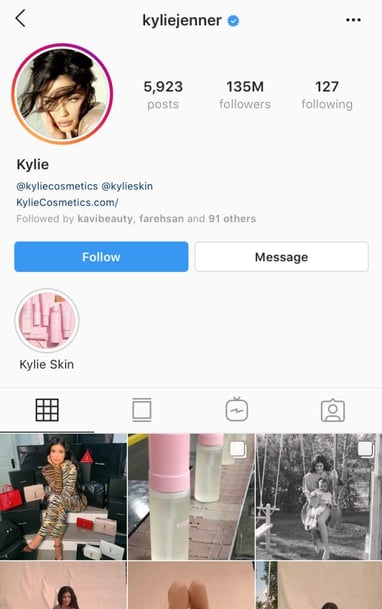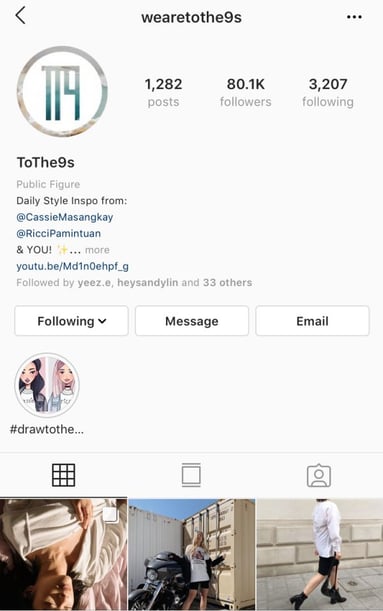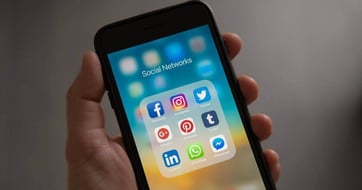Editor's Note: This popular blog post on influencer marketing was updated with new resources and updated content on engagement metrics to track in February 2025.
Influencer marketing has become an extremely effective way for businesses to promote their brand, products, and/or services. But what are micro-influencers, and why are they so valuable for brands?

Over the years, Instagram has become one of the most popular platforms for influencer marketing. With over 2 billion users and a fast-growing network of influencers churning out millions of sponsored posts each year, Instagram has become the most important influencer marketing channel. With that, the word "influencer" has become a rather loose term. There are so many people on Instagram referring to themselves as influencers, but what does that really mean? At the surface, it seems as though an influencer's total number of followers matters the most. However, as a business, there's so much more you have to consider when coming up with an influencer marketing strategy. What can influencers do for your brand? Does their brand align with yours? What kind of relationship do they have with their followers? How do you find the right influencers? How much will it cost? These are all critical questions to consider.
Since there are many facets of influencer marketing, we will focus mainly on the topic of micro-influencers in this blog post.
What is a Micro-Influencer?
Later describes micro-influencers as people who have a significant but not massive social media following. This number is subjective and can range from anywhere between 10,000 to 500,000 followers. The exact number usually depends on who you talk to and the influencer market you are targeting. Micro-influencers have specific niche audiences that are deeply engaged and connected to them. Whether you're a beauty, fitness, fashion, lifestyle, wellness, food, or travel brand, there is probably a large pool of micro-influencers available to reach out to.
Micro-Influencers vs. Macro-Influencers: What Sets Them Apart?
For starters, major social media influencers (or macro-influencers) have attained some sort of "celebrity status". These influencers often have hundreds of thousands (or even millions) of followers, and it probably costs an arm and a leg just to have them promote or endorse a brand's product or service. These types of influencers also tend to lead more lavish lifestyles than your average consumer. Some extreme and notable examples of influencers that fall into this bubble are the Jenners and Kardashians.

On the other hand, micro-influencers are much more like your everyday consumer. Although the criteria of who qualifies as a micro-influencer remain very subjective, they are overall more relatable and personable to their niche audience. If they were to recommend a product or service, it may seem more like a trusted recommendation from a friend rather than a celebrity endorsement.

What Are the Benefits of Micro-Influencers for Your Brand?
Micro-influencers can be extremely valuable for your brand because they've already built a strong following. They've established a certain level of trust and a relationship with their followers through their personal brand. As a marketer, collaborating with micro-influencers can help you cast a wider net to increase your brand visibility. Here's how:
Micro-influencers can help expand your reach. Whether you want to promote a campaign for your business or promote a new product/service, if you work with micro-influencers, you can reach a wider audience. They can promote your brand using videos to help ignite your marketing campaigns or other types of content. It's also more critical than ever before to understand the importance of using Instagram Stories for business, especially when it comes to micro-influencer marketing.
Micro-influencers can help you build lasting relationships. They're more likely to have an engaged and trusting audience, which means their recommendations carry weight. Studies have shown that influencers with a smaller following have a much higher engagement rate than top-tier influencers. Rather than just tagging your business or brand in a post, micro-influencers are more likely to give honest opinions and reviews on your product.
Working with micro-influencers can give you a higher ROI. Rather than spending your entire influencer marketing budget on a macro-influencer celebrity to promote your business or brand, collaborating with a group of micro-influencers can help you get more bang for your buck! This is a great way to save on your marketing spend.
What to Look for in Micro-Influencers
Now that you have a general idea of who micro-influencers are and what they can do for your plan, it's time to find the right micro-influencers for your influencer marketing strategy. Here are a few key considerations to keep in mind:
Make sure they are relevant to your brand. Will they do a good job representing my brand? Do their values align with our brand and business values? Make sure to do your research beforehand and ask yourself these questions. Targeting the wrong micro-influencers will result in a very low ROI.
Engage with them and show appreciation for their content. Realistically, you've got to know why you are contacting specific micro-influencers. Get to know them before reaching out to see if they're a good fit for your marketing strategy. Engage with them and show some appreciation for their content to get a feel for how they interact with their audience. This can help you determine whether or not they are a good fit for your brand.
Look for micro-influencer fans. Conduct an Instagram search to find content that may contain your brand. Follow branded hashtags, and there's a possibility that micro-influencers may already be a part of your brand's fanbase. For example, many micro-influencers in the beauty industry are constantly promoting and tagging different brands' products. They name-drop brands all the time when doing reviews and sharing their makeup and skincare routines. And not all of these posts are sponsored or in collaboration with those brands. Beauty companies like Glossier see this as a unique opportunity to approach these types of micro-influencers because they know they are already an ambassador for their line of products.
How to Find Micro-Influencers
If you're ready to start an influencer campaign, here are some ways to find the right micro-influencers for your business:
Look among your followers and customers
Many of your existing customers may already be talking about your brand online. Engaging with them can lead to organic brand deals and affiliate program opportunities.
Scrolling on social media
Browse platforms like Instagram, TikTok, LinkedIn, and Twitter to find influencers with high engagement rates in your industry. Look for posts that generate meaningful interactions rather than just high follower counts.
Ask Google for suggestions
A quick Google search can help you discover lists of top micro-influencers in your industry. Try searching for terms like "top fitness micro-influencers in 2025" or "best food influencers under 50K followers" to find curated recommendations.
Conduct hashtag searches
Hashtags are powerful tools for finding influencers who specialize in your niche. Search for relevant industry hashtags (e.g., #SkincareTips, #TechReviews, #EcoFriendlyLiving) to uncover micro-influencers who create content that aligns with your brand.
Explore influencer marketing platforms
Influencer marketing platforms provide databases of influencers, making it easier to filter by industry, engagement rate, and location. These tools help streamline your search and ensure you're connecting with influencers who match your marketing goals.
How to Measure the Impact of Micro-Influencers
Partnering with micro-influencers can be highly effective, but measuring their impact is crucial to understanding your ROI and refining your strategy. Here's how to track success:
1. Engagement Metrics
Engagement is one of the strongest indicators of an influencer's impact. Key metrics to monitor include:
- Likes, comments, and shares – Higher engagement means the audience actively interacts with the content.
- Save and share rates – These indicate that the content is valuable enough for users to keep or distribute.
- Comment sentiment – Are people asking questions, tagging friends, or expressing interest in your brand?
2. Follower Growth & Brand Awareness
Micro-influencer campaigns can help increase your brand's visibility. Track:
- New followers on your brand's social media accounts – A spike in followers after a campaign signals increased brand awareness.
- Hashtag mentions and brand tags – More organic conversations around your brand mean the campaign works.
- Reach & impressions – How many people saw the influencer's content? This metric helps measure overall exposure.
3. Website Traffic & Click-Through Rate (CTR)
If your campaign includes trackable links (e.g., UTM codes or promo links), analyze:
- Referral traffic from the influencer's post – Google Analytics can show how many visitors came from their content.
- CTR on influencer-shared links – Are people clicking on the link to learn more?
- Time spent on site & pages viewed – Engaged visitors often browse beyond the landing page.
4. Conversion Rates & Sales
The ultimate goal for most campaigns is driving sales or conversions. You can measure this by:
- Promo codes or affiliate links – Assign unique discount codes to each influencer to track sales directly.
- E-commerce sales attribution – If running an online store, platforms like Shopify or WooCommerce can track influencer-driven sales.
- Lead generation forms – If your goal is lead collection, monitor form completions from influencer-driven traffic.
5. Return on Investment (ROI)
To determine if a micro-influencer campaign was profitable, calculate:
- Cost per engagement (CPE) – Divide the total cost of the campaign by the number of engagements.
- Cost per acquisition (CPA) – Divide the total cost by the number of conversions or sales.
- Customer Lifetime Value (CLV) – Your campaign has long-term value if influencer-driven customers have a high CLV.
6. Brand Sentiment & Customer Feedback
Beyond numbers, qualitative feedback matters:
- Are new customers mentioning the influencer when purchasing?
- Do you notice an increase in positive reviews or discussions about your brand?
- Are customers tagging influencers in follow-up posts to show their purchase?
You can consistently track these metrics to refine your micro-influencer strategy, invest in the most impactful partnerships, and maximize your marketing ROI.
The Future of Micro-Influencers
As influencer marketing evolves, businesses are increasingly looking to leverage micro-influencers for their authenticity, affordability, and ability to create a genuine connection with their audience. With high engagement rates and the power to influence purchasing decisions, micro-influencers will continue to be a go-to strategy for small businesses and major brands alike.
Are You Ready to Launch an Influencer Marketing Campaign?
The Current Social Media Marketing Challenge
Micro-influencers are redefining how brands connect with consumers. Whether you're running a 30-day campaign, launching a new product, or looking for long-term influencer partnerships, the key is to work with influencers who align with your brand's mission and values. If you're still asking, "What are micro-influencers?", then you need to reach out to WSI today! We also offer social media services to improve your brand.






